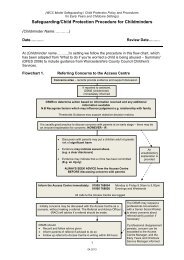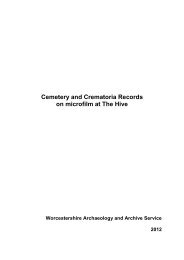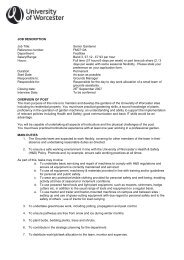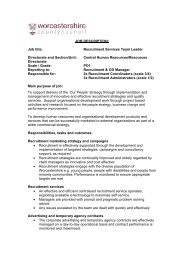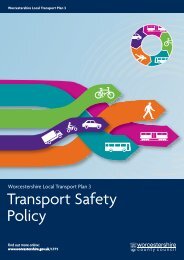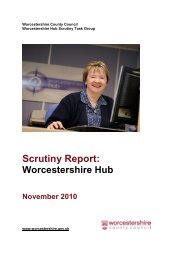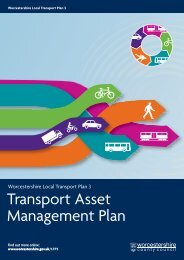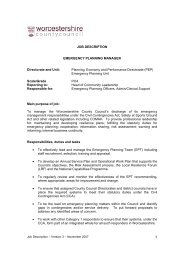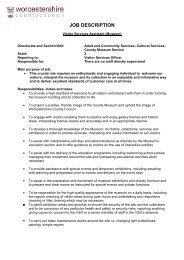Planning for Renewable Energy in Worcestershire Research Paper
Planning for Renewable Energy in Worcestershire Research Paper
Planning for Renewable Energy in Worcestershire Research Paper
You also want an ePaper? Increase the reach of your titles
YUMPU automatically turns print PDFs into web optimized ePapers that Google loves.
APPENDIX A ● <strong>Plann<strong>in</strong>g</strong> <strong>for</strong> <strong>Renewable</strong> <strong>Energy</strong> <strong>in</strong> <strong>Worcestershire</strong>Beyond average w<strong>in</strong>d speed, othertechnical constra<strong>in</strong>ts exist that wouldneed to be overcome be<strong>for</strong>e develop<strong>in</strong>gw<strong>in</strong>d turb<strong>in</strong>es. Access to any potential siteis crucial not only <strong>in</strong> allow<strong>in</strong>g the deliveryand construction of the turb<strong>in</strong>e(s), butalso to allow ma<strong>in</strong>tenance and repair, asand when required. The current logistics<strong>in</strong>volved <strong>in</strong> turb<strong>in</strong>e development meanthat access must be available <strong>for</strong> largevehicles. Similarly, <strong>for</strong> turb<strong>in</strong>es to beconnected to the national grid (which willalmost certa<strong>in</strong>ly be the case <strong>for</strong> largescalew<strong>in</strong>d), adequate provision mustexist to allow connection to thedistribution network. It may not bepossible to connect particularly remoteand/or awkward locations to the gridsystem. In itself, this can be a majorconstra<strong>in</strong>t; many potential sites thatsatisfy other technical and/orenvironmental criteria will be relativelyisolated, and actually erect<strong>in</strong>g theturb<strong>in</strong>es could be so problematic as toeffectively prevent projects go<strong>in</strong>g <strong>for</strong>ward.Potential fund<strong>in</strong>g assistance <strong>for</strong>w<strong>in</strong>d-power projects could be securedthrough the Regional DevelopmentAgency (RDA), which is keen to promoterenewables and low-carbon technology <strong>in</strong>the Rural Regeneration Zone, which<strong>in</strong>cludes Bewdley and its surrounds with<strong>in</strong>its boundary. The RDA states that"…<strong>in</strong>vestment <strong>in</strong> w<strong>in</strong>d power wouldenable local bus<strong>in</strong>esses to benefit fromrenewable energy, which would <strong>in</strong> turn<strong>in</strong>crease the security and diversity of theZone's energy supply and reduce carbonemissions". (Rural Regeneration ZoneAnnual Report 2005-06, Advantage WestMidlands).Environmental designations apply overlarge areas of the County. Whenconsider<strong>in</strong>g sites <strong>for</strong> large w<strong>in</strong>d turb<strong>in</strong>es,the purposes of these designations mustbe taken <strong>in</strong>to account. The w<strong>in</strong>d resourcemapp<strong>in</strong>g referred to above has collatedtogether these designations to <strong>for</strong>m whatit terms 'plann<strong>in</strong>g constra<strong>in</strong>ts', as an<strong>in</strong>dicator of those areas unlikely to besuitable <strong>for</strong> w<strong>in</strong>d energy developments.The mapp<strong>in</strong>g has excluded these areas,together with the urban areas, to arrive atan area of 'deliverable resource'.Accept<strong>in</strong>g this methodology leaves almostall of north <strong>Worcestershire</strong> as unsuitable<strong>for</strong> w<strong>in</strong>d energy development. Thisapproach appears outdated, and is notnecessarily consistent with that of PPS22,which states that the various levels ofdesignation can possibly accommodaterenewables, subject to certa<strong>in</strong> criteria. For<strong>in</strong>ternationally and nationally-designatedsites, the onus is on the developer toprove that the potential development willnot compromise the objectives of thedesignation. It is the responsibility of theLPA to set out criteria-based policiesthrough which acceptability <strong>in</strong> thesedesignations can be decided. Localdesignations alone are not consideredsufficient reason <strong>for</strong> refus<strong>in</strong>g renewableenergy development, and criteria-basedpolicies should aga<strong>in</strong> be employed.In addition to landscape impacts, thereare several other factors that will be ofimportance <strong>in</strong> assess<strong>in</strong>g the viability ofw<strong>in</strong>d turb<strong>in</strong>es <strong>in</strong> any given area. Amongthese are noise; shadow flicker; vibration;effects on radar and TV <strong>in</strong>terference; andwildlife. A DTI study 33 <strong>in</strong>vestigated thenoise associated with w<strong>in</strong>d turb<strong>in</strong>es, andconcluded that "Noise from the w<strong>in</strong>d farmshould be limited to 5dB(A) abovebackground <strong>for</strong> both day- and night-time… remember<strong>in</strong>g that the background levelof each period may be different". Furtherdetails of these issues - which may betermed amenity considerations - can befound <strong>in</strong> the Susta<strong>in</strong>able DevelopmentCommission's 2005 publication 'W<strong>in</strong>dPower <strong>in</strong> the UK.34Technical <strong>Research</strong> <strong>Paper</strong>33Paragraph 21, The Assessment and Rat<strong>in</strong>g of Noisefrom W<strong>in</strong>d Farms, report to DTI (September 1996)




